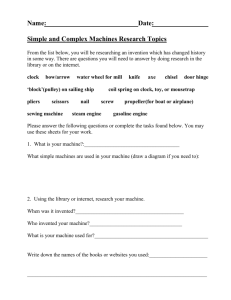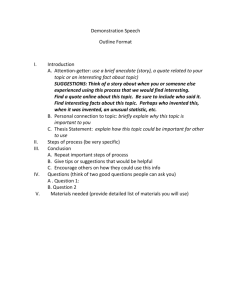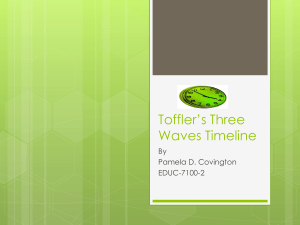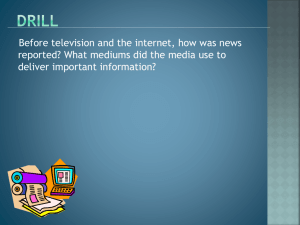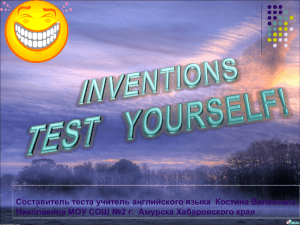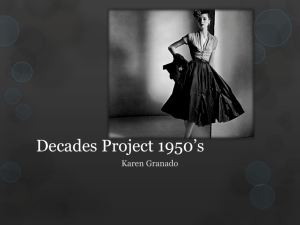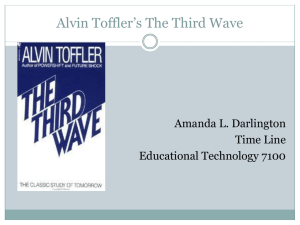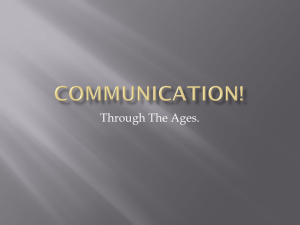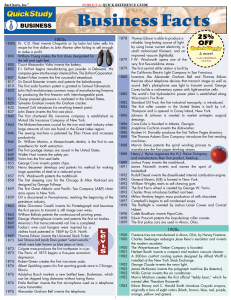Toffler's Wave Theory
advertisement
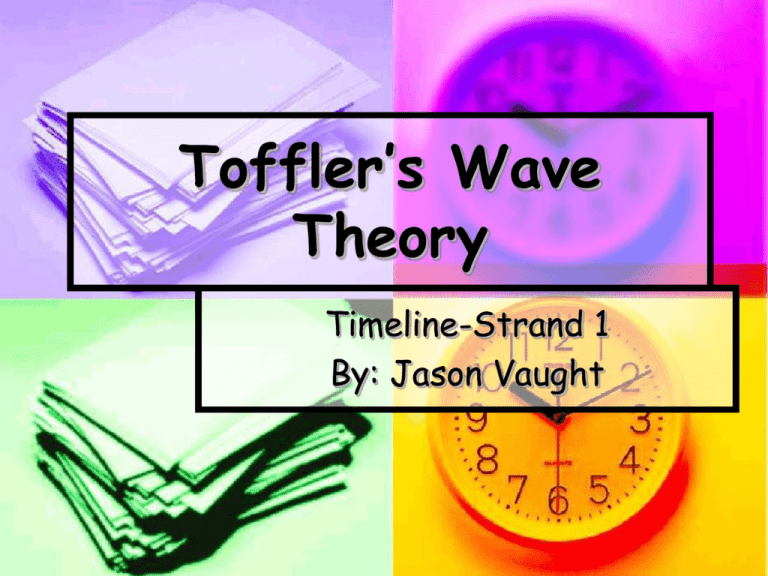
Toffler’s Wave Theory Timeline-Strand 1 By: Jason Vaught AGRICULTURAL AGE 8000 B.C. - 1750 Extended Families. The family business was Agriculture. People traveled by foot or horse and children were homeschooled or learned in a one room school. INDUSTRIAL AGE 1750-1950 Nuclear families. Top down bureaucratic factories. Students were grouped by age and grade levels. Automobiles and planes were introduced. INFORMATION AGE 1955-2005 One parent, two working parents. Automobiles, planes, computers, cell phones and Internet. COMMUNICATION AGE 2005-CURRENT One parent, two working parents. Digital classrooms RESOURCE Toffler, Alvin (1980). The third wave. New York, NY: Bantam Books. Strand 2: Key technological advances and innovations for each decade 1900-1910 Hubert Booth invents the vacuum cleaner in 1901 The Wright brothers’ heavier-than-air Kitty Hawk in 1903 Thomas Edison invents the first talking motion picture in 1910 Charles Strite invents the Pop Up toaster in 1919 1920-1930 Garrett A. Morgan invents a traffic signal in 1923 The mechanical television was invented by John Logie Baird in 1925 1932 Edward Herbert Land invented the Polaroid 1933 Edwin Howard Armstrong created the Frequency modulation (FM) 1940-1950 John Atanasoff and Clifford Berry built the first electronic digital computer in 1942 1946 Percy Spencer invented the microwave oven Charles Ginsburg invented the first video tape recorder in 1951 Fortran computer language was invented in 1957 1960-1970 1962- Audio cassette 1964- BASIC computer language was invented by John George Kemeny and Tom Kurtz Robert Metcalfe and Xerox invented ethernet in 1973 1979- Cell phones 1980-1990 1981- the first IBM-PC was invented 1984- the Apple Macintosh was invented 1993- the pentium processor 1996- Web TV invented 2000 and beyond… 2001- Apple computers announced their portable music digital player the iPod Resources http://www.associatedcontent.com/article/1 7372/technology_changes_and_inventions _in.html http://inventors.about.com/od/ti melines/a/twentieth_3.htm Strand 3: The nature of work: Business and corporate philosophies 1900-1910 24 million U.S. registered workers age 10 and above in 1900 1900- Only 19% of women of working age participated in the work force 1913 The U.S. government establishes the Department of Labor 1919 a record 4 million workers strike 1920-1930 1920 Farm organization set up lobbies in Washington 1929 Stock market crashes on October 24 known as “Black Thursday” 1930-1933 The Great Depression begins 1938 Fair Labor Standards Act establishes the minimum wage 1940-1950 1947 American investments abroad reached an all time high of 26.7 billion 1949 Fair Labor Standards Act outlaws child labor 1950-31 percent of U.S. women worked outside the home 1950- the first Xerox copy machined was produced 1960-1970 1963 Congress passes the Equal Pay Act 1969 the first automated teller machine begins operating in Rockville Centre, N.Y. 1975-Founding of Microsoft 1970sWatergate affair 1980-1990 1980Unemployment averages 7.1 percent On January 1, the average car costs $7,574 1998- Google was founded 1990sInception of the internet for commerce Resources http://inventors.about.com/od/timelines/a/twentieth_3.htm Strand 4: Educational theories of learning and instruction 1900-1910 1901- John Dewey interpreted the method of empirical science in educational terms 1902 Edward Thorndike offered the 1st course in educational measurements at Columbia University Frederic Burk developed on of the 1st systems of individual instruction at the San Francisco State Normal School in 1912 Washburne’s Winnetka Plan was developed in 1919 1920-1930 Henry Clinton Morrison’s Morrison Plan (1925-1935) Lewin’s Field Theory and Science of Instruction were experimented in the late 1920s 1933- Ralph W. Tyler Eight Year Study use of general and behavioral objectives and formative evaluation 1934- William Bagley writes Education and Emergent Man 1940-1950 1946 Edgar Dale developed the Cone of Experience 1949 Ralph Tyler publishes Basic Principles of Curriculum and Instruction 1954 B.F. Skinner publishes The Science of Learning and the Art of Teaching 1956 Benjamin Bloom’s Taxonomy of Educational Objectives 1960-1970 1965 Elementary and Secondary Education Act (ESEA) was established 1969 First broadcast of Sesame Street 70’s –Criterion Referenced Instruction (CRI) is introduced by Robert Mager 1976- Steve Jobs and Steve Wozniak desige the Apple I computer 1980-1990 1983 Howard Gardner publishes Multiple Intelligences 1983 MD Merrill established the Component Display Theory 1995 Bernie Dodge and Tom March developed Webquest 1990s use of multimedia in instruction 2000… Jeroen J G van Merrienboer refines the Four Component Instructional Design System David Wiley develops Learning Object Design and Sequencing Theory (LODAS) Resources http://myecoach.com/project.php?id=121 52&project_step=26137 Strand 5: Nature of society and culture: What key events determined the thinking of the decade? 1900-1910 1903 Orville Wright heavierthan-air machine flight 1907 1st successful human blood transfusion 1916 Americas worst polio epidemic 1918 Spanish influenza killed over 500,000U.S. worst single epidemic 1920-1930 1920 19th Amendment to the Constitution granting women the right to vote 1928 Walt Disney dreams up Mickey Mouse 1931- The Empire State Building was completed 1938 Cloning envisioned by Dr. Hans Spemann in Germany 1940-1950 1939-1945 World War II 1945 first vaccine for influenza 1954 Brown v. BOE of Topeka Kansas 1958 Bank of America issued the first bank credit card, BankAmericard (now Visa) 1960-1970 1963 the assassination of John F. Kennedy 1965 Executive Order 11246 enforces affirmative action for first time 1972 President Nixon signs into law U.S. Father’s Day the 3rd Sunday of June 1973 Roe v. Wade 1980-1990 1982 Michael Jackson releases Thriller 1986 Space Shuttle Challenger disaster 1993 “Don’t Ask, Don’t Tell” policy is instituted for the U.S. Military 1999 Columbine High School massacre 2000… Vermont becomes the first state in the country to legally recognize civil unions between gay or lesbian couples George W. Bush accepts the presidency after Florida ballot controversy References http://www.infoplease.com/spot/t imelinearchive.html Strand 6: Political… 1905-Russian Revolution begins 1907- 2nd Haque Peace Conference 1912- Balkan Wars 1914-1918 World War I 1920- 19th Amendment ratified (Women’s suffrage) 1923- Adolf Hitler’s “Beer Hall Putsch” in Munich fails 1930s-Great Depression Uprise of Facism in the 1930s World War II (1939-1945) 1942- Declaration of United Nations signed in Washington 1945 the U.S. and Soviet Union emerged as powerful nations Korean War (1950-1953) Vietnam War(1957-1975) The Great Chinese Famine (1959-1962) 1961 U.S. breaks diplomatic relations with Cuba 1972- President Nixon Watergate Scandal 1973 Roe v. Wade Global warming awareness began in the 80s The U.S. developed the Space Shuttle program in 1981 Operation Desert Storm- 1990 Persian Gulf War (1990-1991) 2001- 9/11 Terrorist attack in New York Resources http://www.gwu.edu/~nsarchiv/NSAEBB/NSAEBB39/ http://www.infoplease.com/ip a/A0005251.html http://en.wikipedia.org/wiki/20th_ century http://watergate.info/
